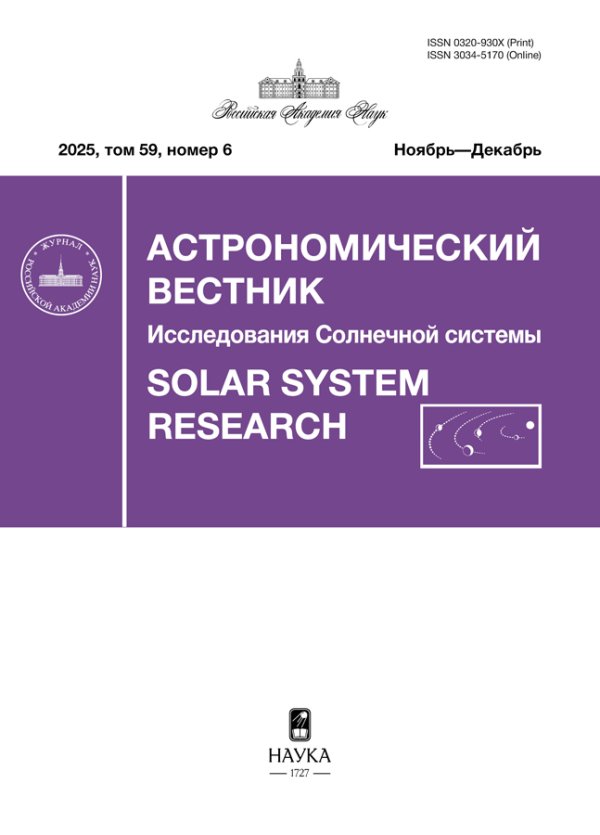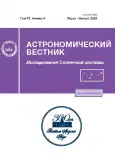ExoMars-2022 Mission ODS Instrument: Modeling and Ground Field Measurements
- Authors: Khorkin V.S.1,2, Fedorova A.A.1, Dobrolenskiy Y.S.1, Korablev O.I.1, Vyazovetskiy N.A.1, Dzyuban I.A.1, Sapgir A.G.1, Titov A.Y.1, Toledo D.3, Pommereau J.4, Rannou P.3
-
Affiliations:
- Space Research Institute of the Russian Academy of Sciences, Moscow, Russia
- Faculty of Physics Lomonosov Moscow State University, Moscow, Russia
- Instituto Nacional de Técnica Aerospacial, Madrid, Spain
- LATMOS, Université de Versailles-St-Quentin, Guyancourt, France
- Issue: Vol 57, No 4 (2023)
- Pages: 307-318
- Section: Articles
- URL: https://journals.rcsi.science/0320-930X/article/view/134978
- DOI: https://doi.org/10.31857/S0320930X23040059
- EDN: https://elibrary.ru/REFZHQ
- ID: 134978
Cite item
Full Text
Abstract
The paper presents the results of modeling and ground-based field measurements of the ODS (Optical Depth Sensor) instrument, designed to study aerosol in the Martian atmosphere through daily measurements of illumination on the planet’s surface. The device was part of the meteo suite located on the landing platform of the ExoMars-2022 mission. The article presents the structure of the instrument, its optical design and the spectral characteristics of two channels. The main elements of the model for calculating the radiation flux measured by the instrument are described depending on the structure of the atmosphere, the aerosol suspended in it, and the daily motion of the Sun. The calculations were carried out in the approximation of a pseudospherical atmosphere, taking into account the multiple scattering of radiation. Using the created model adapted for the Earth’s atmosphere, the ODS signal was simulated for two series of ground-based field measurements at different latitudes. The measured daily dependences in comparison with the simulation results make it possible to determine the optical depth with an accuracy of 0.1.
Keywords
About the authors
V. S. Khorkin
Space Research Institute of the Russian Academy of Sciences, Moscow, Russia; Faculty of Physics Lomonosov Moscow State University, Moscow, Russia
Email: vs_khorkin@mail.ru
Россия, Москва; Россия, Москва
A. A. Fedorova
Space Research Institute of the Russian Academy of Sciences, Moscow, Russia
Email: vs_khorkin@mail.ru
Россия, Москва
Yu. S. Dobrolenskiy
Space Research Institute of the Russian Academy of Sciences, Moscow, Russia
Email: vs_khorkin@mail.ru
Россия, Москва
O. I. Korablev
Space Research Institute of the Russian Academy of Sciences, Moscow, Russia
Email: vs_khorkin@mail.ru
Россия, Москва
N. A. Vyazovetskiy
Space Research Institute of the Russian Academy of Sciences, Moscow, Russia
Email: vs_khorkin@mail.ru
Россия, Москва
I. A. Dzyuban
Space Research Institute of the Russian Academy of Sciences, Moscow, Russia
Email: vs_khorkin@mail.ru
Россия, Москва
A. G. Sapgir
Space Research Institute of the Russian Academy of Sciences, Moscow, Russia
Email: vs_khorkin@mail.ru
Россия, Москва
A. Yu. Titov
Space Research Institute of the Russian Academy of Sciences, Moscow, Russia
Email: vs_khorkin@mail.ru
Россия, Москва
D. Toledo
Instituto Nacional de Técnica Aerospacial, Madrid, Spain
Email: vs_khorkin@mail.ru
Spain, Madrid
J.-P. Pommereau
LATMOS, Université de Versailles-St-Quentin, Guyancourt, France
Email: vs_khorkin@mail.ru
France, Guyancourt
P. Rannou
Instituto Nacional de Técnica Aerospacial, Madrid, Spain
Author for correspondence.
Email: vs_khorkin@mail.ru
Spain, Madrid
References
- Каталог производственной компании ООО “Электростекло”, Спектральные характеристики пропускания образцов цветного стекла. http://www.elektrosteklo.ru/Elektrosteklo_Color_Glass_Spectral_ Transmittance.pdf
- Тимофеев Ю.М., Васильев А.В. Теоретические основы атмосферной оптики. Санкт-Петербург: Наука, 2003. 473 с.
- Bodhaine B.A., Wood N.B., Dutton E.G., Slusser J.R. On Rayleigh Optical Depth Calculations // J. Atmospheric and Oceanic Technology. 1999. V. 16. P. 1854–1861.
- Cantor B.A. MOC observations of the 2001 Mars planet-encircling dust storm // Icarus. 2007. V. 186. P. 60–96. https://doi.org/10.1016/j.icarus.2006.08.019
- Clancy R.T., Sandor B.J., Wolff M.J., Moriarty-Schieven G. The orbital (Ls) variation of thermal structure over the 60–80 km Mars atmospheric region // J. Geophys. Res. 2000. V. 105. № E4. P. 9553– 9572.
- Evans K.F. SHDOMPPDA: A Radiative Transfer Model for Cloudy Sky Data Assimilation // J. Atmos. Sci. Special section. 2007. P. 3854–3864. https://doi.org/10.1175/2006JAS2047.1.
- Fedorova A.A., Rodin A.V., Baklanova I.V. Seasonal cycle of water vapor in the atmosphere of Mars as revealed from the MAWD/Viking 1 and 2 experiment // Sol. Syst. Res. 2004. V. 38. P. 421–433. https://doi.org/10.1007/s11208-005-0009-2
- Guzewich S.D., Lemmon M., Smith C.L., Martínez G., de Vicente-Retortillo Á., Newman C.E., Baker M., Campbell C., Cooper B., Gómez-Elvira J., Harri A.-M., Hassler D., Martin-Torres F.J., McConnochie T., Moores J.E., Kahanpää H., Khayat A., Richardson M.I., Smith M.D., Sullivan R., Juarez M.T., Vasavada A.R., Viúdez-Moreiras D., Zeitlin C., Mier M.-P.Z. Mars Science Laboratory observations of the 2018/Mars year 34 global dust storm // Geophys. Res. Lett. 2019. V. 46. P. 71–79. https://doi.org/10.1029/2018GL080839
- Haberle R., Clancy R., Forget F., Smith M., Zurek R. The Atmosphere and Climate of Mars. Cambridge: Cambridge Univ. Press, 2017. 588 p. https://doi.org/10.1017/9781139060172
- Hamamatsu datasheet, https://www.hamamatsu.com/eu/en/ product/optical-sensors/photodiodes/si-photodiodes/ S1336-8BK.html
- Harri A.-M., Linkin V., Polkko J., Marov M., Pommereau J.-P., Lipatov A., Siili T., Manuilov K., Lebedev V., Lehto A., Pellinen R., Pirjola R., Carpentier T., Malique C., Makarov V., Khloustova L., Esposito L., Maki J., Lawrence G., Lystsev V. Meteorological observations on Martian surface: Met-packages of Mars-96 Small Stations and Penetrators // Planet. and Space Sci. 1998. V. 46. Iss. 6–7. P. 779–793. https://doi.org/10.1016/S0032-0633(98)00012-9
- Hersbach H., Bell B., Berrisford P., Hirahara S., Horányi A., Muñoz-Sabater J., Nicolas J., Peubey C., Radu R., Schepers D., Simmons A., Soci C., Abdalla S., Abellan X., Balsamo G., Bechtold P., Biavati G., Bidlot J., Bonavita M.,Chiara G., Dahlgren P., Dee D., Diamantakis M., Dragani R., Flemming J., Forbes R., Fuentes M., Geer A., Haimberger L., Healy S., Hogan R., Hólm E., Janisková M., Keeley S., Laloyaux P., Lopez P., Lupu C., Radnoti G., Rosnay P., Rozum I., Vamborg F., Villaume S., Thépaut J.-N. The ERA5 global reanalysis // Quart. J. Roy. Meteorolog. Soc. 2020. V. 146. Iss. 730. P. 1999–2049. https://doi.org/10.1002/qj.3803
- Kleinboehl A., Spiga A., Kass D.M., Shirley J.H., Millour E., Montabone L., Forget F. Diurnal variations of dust during the 2018 global dust storm observed by the Mars Climate Sounder // J. Geophys. Res.: Planets. 2020. V. 125. id. e2019JE006115 (21 p.). https://doi.org/10.1029/2019JE006115.
- Lemmon M.T., Wolff M.J., Bell J.F., Smith M.D., Cantor B.A., Smith P.H. Dust aerosol, clouds, and the atmospheric optical depth record over 5 Mars years of the Mars Exploration Rover mission // Icarus. 2015. V. 251. P. 96–111. https://doi.org/10.1016/j.icarus.2014.03.029
- Linkin V., Harri A.-M., Lipatov A., Belostotskaja K., Derbunovich B., Ekonomov A., Khloustova L., Kremnev R., Makarov V., Martinov B., Nenarokov D., Prostov M., Pustovalov A., Shustko G., Järvinen I., Kivilinna H., Korpela S., Kumpulainen K., Lehto A., Pellinen R., Pirjola R., Riihelä P., Salminen A., Schmidt W., Siili T., Blamont J., Carpentier T., Debus A., Hua C.T., Karczewski J.-F., Laplace H., Levacher P., Lognonné Ph., Malique C., Menvielle M., Mouli G., Pommereau J.-P., Quotb K., Runavot J., Vienne D., Grunthaner F., Kuhnke F., Musmann G., Rieder R., Wänke H., Economou T., Herring M., Lane A., McKay C.P. A sophisticated lander for scientific exploration of Mars: scientific objectives and implementation of the Mars-96 Small Station // Planet. and Space Sci. 1998. V. 46. P. 717–737. https://doi.org/10.1016/S0032-0633(98)00008-7
- Lorenz R.D., Martínez G.M., Spiga A., Vicente-Retortillo A., Newman C.E., Murdoch N., Forget F., Millour E., Pierron T. Seasonal deposition and lifting of dust on Mars as observed by the Curiosity Rover // Planet. and Space Sci. 2021. V. 207. 14 p. https://doi.org/10.1016/j.pss.2021.105337.
- Maria J.-L., Tran T.T., Pommereau J.-P., Rannou P., Malique C., Correia J.J., Porteneuve J. Scientific aspects of the optical depth sensor // Adv. Space Res. 2006. V. 38. P. 726–729. https://doi.org/10.1016/j.asr.2005.08.021
- Markiewicz W., Sablotny R., Keller H., Thomas N., Titov D., Smith P. Optical properties of the Martian aerosols as derived from Imager for Mars Pathfinder midday sky brightness data // J. Geophys. Res. 1999. V. 104. P. 9009–9017. https://doi.org/10.1029/1998JE900033
- Markiewicz W.J., Keller H.U., Thomas N., Titov D., Forget F. Optical properties of the Martian aerosols in the visible spectral range // Adv. Space Res. 2002. V. 29. Iss. 2. P. 175–181. https://doi.org/10.1016/S0273-1177(01)00567-1
- Martin L.J. The Major Martian Dust Storms of 1971 and 1973 // Icarus. 1974. V. 23. P. 108–115. https://doi.org/10.1016/0019-1035(74)90108-0
- Montabone L., Forget F., Millour E., Wilson R.J., Lewis S.R., Cantor B., Kass D., Kleinböhl A., Lemmon M.T., Smith M.D., Wolff M.J. Eight-year climatology of dust optical depth on Mars // Icarus. 2015. V. 251. P. 65–95. https://doi.org/10.1016/j.icarus.2014.12.034
- Montabone L., Spiga A., Kass D.M., Kleinboehl A., Forget F., Millour E. Martian year 34 column dust climatology from Mars climate sounder observations: Reconstructed maps and model simulations // J. Geophys. Res.: Planets. 2020. V. 125. id. e2019JE006111 (30 p.). https://doi.org/10.1029/2019JE006111.
- Montmessin F., Rannou P., Cabane M. New insights into Martian dust distribution and water-ice cloud microphysics // J. Geophys. Res.: Planets. 2002. V. 107. Iss. E6. P. 4.1–4.14. https://doi.org/10.1029/ 2001JE001520.
- Smith P.H., Tomasko M.G., Britt D., Crowe D.G., Reid R., Keller H.U., Thomas N., Gliem F., Rueffer P., Sullivan R., Greeley R., Knudsen J.M., Madsen M.B., Gunnlaugsson H.P., Hviid S.F., Goetz W., Soderblom L.A., Gaddis L., Kirk R. et al. The imager for Mars Pathfinder experiment // J. Geophys. Res. 1997. V. 102. № E2. P. 4003–4025. https://doi.org/10.1029/96JE03568
- Smith M.D. THEMIS observations of Mars aerosol optical depth from 2002–2008 // Icarus. 2009. V. 202. P. 444–452. https://doi.org/10.1016/J.ICARUS.2009.03.027
- Toledo D. Preparation and validation of the cloud and dust opacity sensor ODS for ExoMars 2018 mission // Candidate’s thesis, Reims. 2015. 182 p.
- Toledo D., Rannou P., Pommereau J.-P., Foujols T. The optical depth sensor (ODS) for column dust opacity measurements and cloud detection on Martian atmosphere // Exp. Astron. 2016a. V. 42. P. 61–83. https://doi.org/10.1007/s10686-016-9500-7
- Toledo D., Rannou P., Pommereau J.-P., Sarkissian A., Foujols T. Measurement of aerosol optical depth and sub-visual cloud detection using the optical depth sensor (ODS) // Atmos. Meas. Tech. 2016b. V. 9. P. 455–467. https://doi.org/10.5194/amt-9-455-2016
- Toledo D., Arruego I., Apéstigue V., Jiménez J.J., Gómez L., Yela M., Rannou P., Pommereau J.-P. Measurement of dust optical depth using the solar irradiance sensor (SIS) onboard the ExoMars 2016 EDM // Planet. and Space Sci. 2017. V. 138. P. 33–43. https://doi.org/10.1016/j.pss.2017.01.015
- Tran T.T., Pommereau J.-P., Rannou P., Maria J.-L. Technical aspect of the optical depth sensor // Adv. Space Res. 2005. V. 36. P. 2182–2186. https://doi.org/10.1016/j.asr.2005.07.079
- Vincendon M., Audouard J., Altieri F., Ody A. Mars express measurements of surface albedo changes over 2004–2010 // Icarus. 2015. V. 251. P. 145–163. https://doi.org/10.1016/j.icarus.2014.10.029
- Zelenyi L.M., Korablev O.I., Rodionov D.S., Novikov B.S., Marchenkov K.I., Andreev O.N., Larionov E.V. Scientific Objectives of the Scientific Equipment of the Landing Platform of the ExoMars-2018 Mission // Sol. Syst. Res. 2015. V. 49. № 7. P. 509–517.
- Zurek R.W. Martian great dust storms: An update // Icarus. 1982. V. 50. Iss. 2–3. P. 288–310. https://doi.org/10.1016/0019-1035(82)90127-0
Supplementary files



















